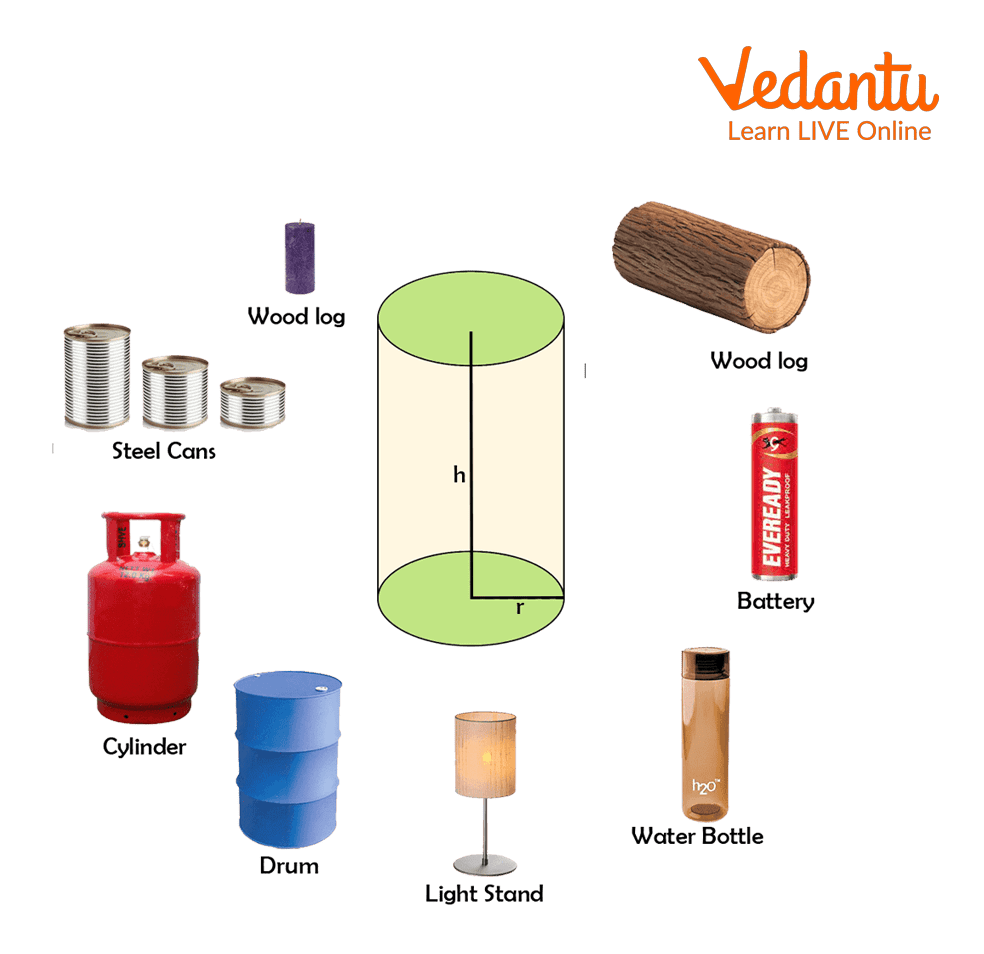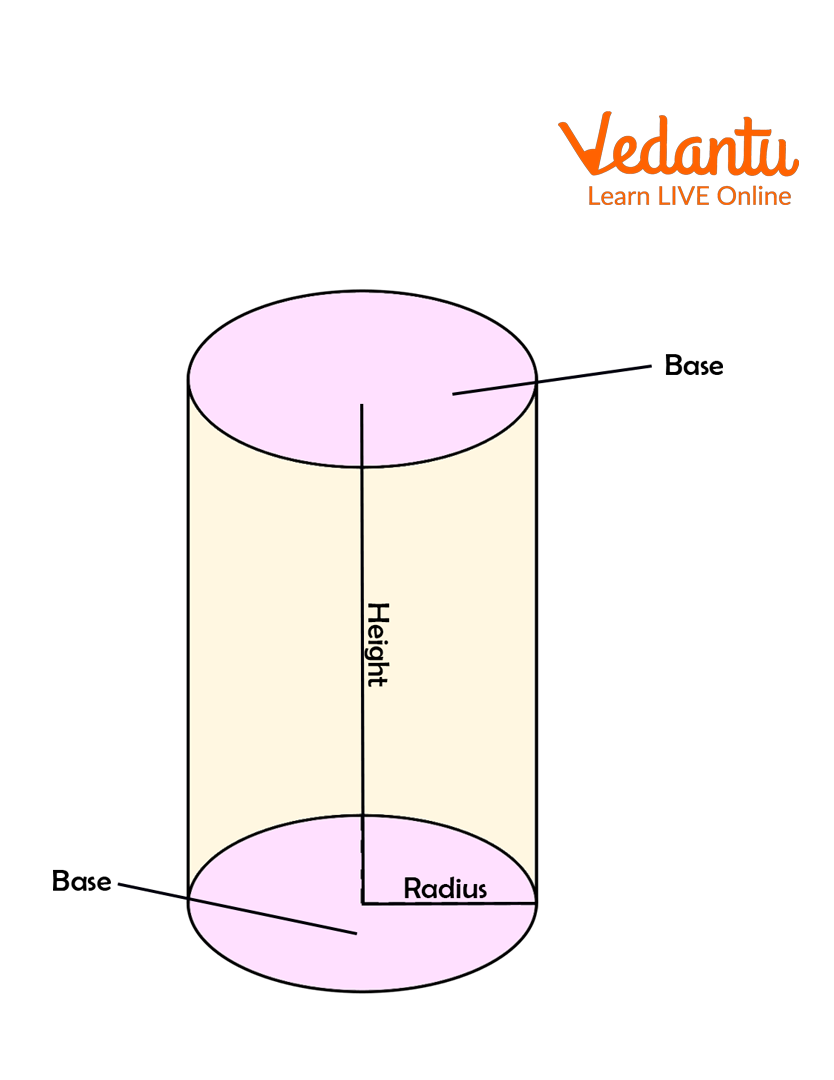




Circular Cylinder: A Popular Geometrical Shape
In this article, we'll learn all about cylinders, which are among the most common three-dimensional shapes we encounter in our daily lives. A cylinder is quite a popular geometrical shape. It is the foundation of many interesting everyday products, such as a can, gas cylinders, rollers, tube lights, chalk, pipe, batteries, cylindrical tumblers/flask, drums, and so on. These solids have circular shape bases that are congruent and parallel. Can you find any cylindrical shapes in your surroundings?

Cylindrical Shapes
What is the Right-Circular Cylinder?
A right-circular cylinder can be defined as a three-dimensional solid geometrical figure of two parallel circular shapes joined by a curved surface. The ends of the right circular cylinder are closed circles and are congruent and parallel to one another. The right cylinder is another name for a right circular cylinder.

Cylinder
Parts of Cylinder
Base: It refers to each of a right circular cylinder's circular ends.
Axis: It refers to the line segment that connects the centres of two circular bases and is perpendicular to the base of the right circular cylinder.
Radius (r): It refers to the circular base's radius.
Height (h): It refers to the length of the cylinder's axis.
Properties of the Right-Circular Cylinder
Some properties of the right-circular cylinder are:
There are two edges present in a right circular cylinder.
The right cylinders have no corners so zero vertices are present.
Cylindrical bases are always parallel to one another.
The shape we obtain is a circle if a plane cuts the right cylinder horizontally and parallel to the bases.
A right cylinder is created when a rectangle is rotated around one side as the axis of revolution.
Longest diagonal of a cylinder is given by
Lateral or Curved Surface Area of the Right-Circular Cylinder
The total area that the figure's curving surfaces cover is known as the CSA. It has a square unit of measurement. The lateral surface of the right circular cylinder is the curved surface that links the two circular shape bases, and its area is given by:
Total Surface Area of the Right-Circular Cylinder
The total surface area of the right circular cylinder is equal to the sum of the bases of both circles plus the CSA.
Volume of the Right-Circular Cylinder
The volume of any 3-D solid is the amount of space it can hold. It is measured in cubic units like
Solved Examples of Cylinders
Example 1: Find the volume of the right cylinder whose height is 20 cm and radius is 5 cm. Take
Solution: Given h=20 cm and r=5cm
We know that the volume of the right-circular cylinder is given by:
Example 2: The radius and height of a right circular cylinder are given as 2.4 m and 6 m, respectively. Find the lateral and total surface area of the right cylinder. Take
Solution: Given r=2.4 m and h=6m
We know that the lateral or curved surface area of the right-circular cylinder is given by:
Now, for the total surface area;
Practice on Your Own
Q1. Find the total surface area and volume of the right-circular cylinder whose radius and height are 5 cm and 14.9, respectively. Take
Q2. Find the radius of the cylinder whose lateral surface area is 5024
Ans1: TSA=624.86
Ans2: 100 m.
Quick Summary
Below is a quick summary on the topic right circular cylinder. For more details, you can access the free resources available on the Vedantu website for the state board, CBSE, ICSE, and competitive examinations.
Conclusion
In this article, we have discussed that a cylinder is a 3-D geometric figure having two parallel circular shapes joined by a curved surface. When the axis is perpendicular to the radius, the cylinder is referred to as a right circular cylinder. The real-life cylinder examples provided in this article will assist you in quickly recognizing the cylindrical shapes that surround us.
FAQs on Right Circular Cylinder
1. What is the Right Circular Cone?
Right Circular Cone can be defined as,
A right circular cone is a solid generated by revolving a line segment that passes through a fixed point and which makes a constant angle with a fixed line.
Here you see a right circular cone with ‘h’ is the height of the cone, ‘r’ is the radius of the cone, and L is the slant height of the cone.
2. What is the difference between Cylinder and Right Circular Cylinder?
Cylinder and Right Circular Cylinder are similar shapes with a slight difference in the inclination angle of the axis with the base. Some of the differences are:
The line segment joining the centres of two circular bases perpendicular to the base of the right circular cylinder is called the axis of the right circular cylinder.
While in a regular cylinder the axis of the cylinder can have any inclination with the circular base.
Also, the cross-section of a right circular cylinder is a rectangle or a square while of a regular cylinder, it is a parallelogram.
3. What is the difference between the cylinder and the right circular cylinder?
Any prism shape solid which has a base of circular shape is called a cylinder. If the segment joining the centres of the circle of the cylinder is perpendicular to the base then, that cylinder is called a right circular cylinder. Whereas in a regular cylinder, the axis can have any inclination with the base. The cross-section in the right circular cylinder is that of a square or rectangle. Whereas in a normal cylinder the cross-section is a parallelogram.
4. What are the dimensions of the cylinder?
The cylinder is a three-dimensional shape in geometry in which the top and bottom have the same sizes. It is a Prism solid shape having the base of circular shape. There are two main dimensions involved with the cylinder that is the radius of the base, and height. The radius/diameter of the top and the bottom base is the same and height represents the distance between the two circular surfaces of the cylinder.
5. How to find the volume of any given cylinder?
The cylinder is a three-dimensional shape that involves two main parameters that are the radius of the base and the height of the cylinder. The volume of a cylinder is given as V = 𝝅r2h where r is the radius of the base, h is the height of the cylinder and 𝝅 = constant equal to 3.14. By substituting the values of 𝝅, radius and height, the volume of any cylinder can be found.
6. What is the number of edges and vertices on a right circular cylinder?
A circular cylinder has two curved edges, one curved surface, and two flat faces. The bases are always congruent with one another. There are two edges present in a right circular cylinder. Combining two circles and one rectangle yields a right circular cylinder. The curved edges of the cylinder shape are by folding the two straight edges of the rectangle. Since these cylinders have no corners, zero vertices are present.
7. What is the contrast between a cylinder and a right circular cylinder?
The cylinder and right circular cylinder are cylindrical shapes, but they differ slightly in the angle at which the axis meets the base. A simple or regular cylinder can be slightly inclined or right circular in shape. The circle bases of a right-circular cylinder are parallel and congruent circles, and each line segment of the lateral curved surface is perpendicular to the bases. In the cylinder, the axis can have any inclination with the base.
8. What is a cylinder's diameter?
The longest length that can be found on the circular bases and that passes through the centres of the circles is equivalent to the diameter of a cylinder. The diameter and radius are frequently used together to determine a cylinder's volume and surface area. Similarly, if we know the volume or surface area of the cylinder, we can also determine the length of the diameter. By multiplying the radius by two, we can quickly determine the diameter if we know the radius.























